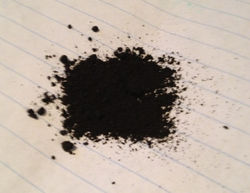Copper chromite
 Freshly made copper chromite for use as a catalyst for pyridine.
| |
| Names | |
|---|---|
| Other names
Adkins catalyst
Copper(II) chromium(III) oxide Lazier catalyst Oxo-(oxochromiooxy)chromium Oxocopper | |
| Properties | |
| Cu2Cr2O5 2CuO·Cr2O3 | |
| Molar mass | 311.0812 g/mol |
| Appearance | Black solid |
| Odor | Odorless |
| Melting point | Decomposes |
| Boiling point | Decomposes |
| Insoluble | |
| Hazards | |
| Safety data sheet | FischerScientific |
| Related compounds | |
| Related compounds
|
Copper(II) oxide |
| Except where otherwise noted, data are given for materials in their standard state (at 25 °C [77 °F], 100 kPa). | |
| Infobox references | |
Copper chromite is an inorganic compound that finds use in organic chemistry as a catalyst. The names oxocopper and chromium(III) copper(II) oxide also refer to this compound. Despite the name, it does not contain the chromite anion, instead having the chemical formula Cu2Cr2O5 or 2CuO·Cr2O3.
Contents
Properties
Chemical
Copper chromite is of greatest interest to the home chemist as a catalyst, such as in the synthesis of pyridine from niacin. Like Raney nickel, it is used in hydrogenation reactions in organic chemistry.
Physical
Copper chromite typically appears as a dusty black or green-black powder.
Availability
Copper chromite is not readily obtainable outside of chemical suppliers, from which it is very expensive to buy, but is easily made using common reagents.
Preparation
Copper chromite is usually produced by thermal decomposition of copper ammonium chromate, which is easily prepared from copper(II) sulfate, ammonium, sodium, or potassium dichromate, and aqueous ammonia, with ammonia being the limiting reagent as its addition causes precipitation. The solutions of the three compounds can be combined in any order provided that ammonia is not added to copper(II) sulfate, as this will form copper(II) hydroxide and/or the tetraammine copper(II) complex. The copper ammonium chromate precipitates as an orange-brown solid, and can be washed, dried, and finally heated for a period of time at about 350°C to produce the final product of copper chromite, identifiable by a uniform black color.
Projects
- Synthesis of pyridine
Handling
Safety
There is not an abundant amount of information regarding the toxicity of copper chromite outside of its potential as an irritant. Gloves are recommended, as well as a well-ventilated environment if working with dry, dusty samples.
Storage
Copper chromite is thermally and air-stable, and can be stored in most containers. It is not thought to be any more reactive than its component oxides.
Disposal
As with most copper or chromium compounds, disposal directly into the environment in any way is advised against due to their effects on plants and other lifeforms. Landfill disposable is suitable, however. You can also try to recycle its components.